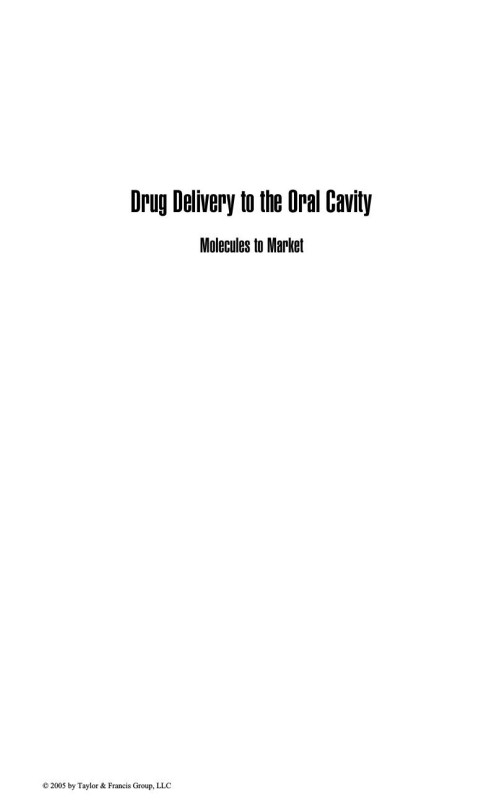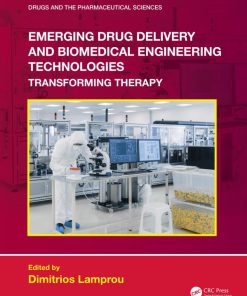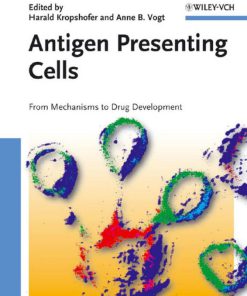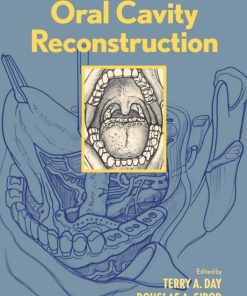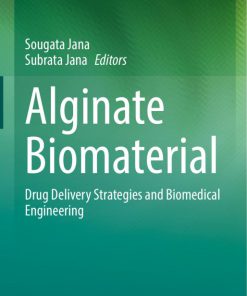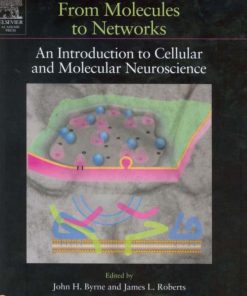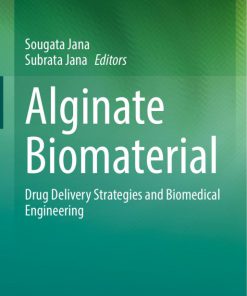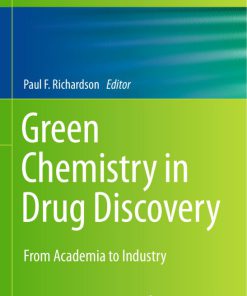Drug Delivery to the Oral Cavity Molecules to Market 1st edition by Tapash Ghosh,William Pfister 9780849398513 0849398517
$50.00 Original price was: $50.00.$25.00Current price is: $25.00.
Authors:Tapash K. Ghosh; William R. Pfister , Tags:Front Matter , Author sort:Ghosh, Tapash K. & Pfister, William R. , Published:Published:Nov 2006 , Comments:Comments:Front Matter
Drug Delivery to the Oral Cavity Molecules to Market 1st edition by Tapash Ghosh,William Pfister – Ebook PDF Instant Download/Delivery.9780849398513,0849398517
Full download Drug Delivery to the Oral Cavity Molecules to Market 1st edition after payment

Product details:
ISBN 10:0849398517
ISBN 13:9780849398513
Author:Tapash Ghosh,William Pfister
With contributions from recognized authorities in industry, academia, and government, this reference presents the state-of-the-art in the testing, formulation, and clinical evaluation of intraoral drug delivery products-summarizing intraoral dosage forms in various stages of research, as well as products currently on the market.
Intraoral Delivery Systems: An Overview, Current Status, and Future Trends
I. Introduction
II. Intraoral Drug Delivery
A. Product Market
B. Anatomy of Oral Cavity
C. Intraoral Drug Delivery
D. Intraoral Drug Absorption
III. Overview: Intraoral Delivery Systems
A. Routes of Administration
B. Classification of Intraoral Dosage Forms
1. Quick-Dissolving Delivery Systems
2. Slow-Dissolving Delivery Systems
3. Nondissolving Delivery Systems
IV. Current Status: Intraoral Drug Delivery
A. Quick-Dissolving Delivery Systems
1. Lyophilized Wafers
2. Orally Disintegrating Tablets
3. Thin Films and Strips
4. Quick-Dissolve Products
5. Intraoral Liquid Delivery Technology
B. Slow-Dissolving Delivery Systems
1. Buccal Tablets
2. Slow-Dissolve Products
C. Nondissolving Delivery Systems
1. Medicated Chewing Gums
2. Buccal Patches
V. Intraoral Drug Delivery Excipients
VI. Intraoral Dosage Form Barrier Packaging
VII. Future Trends: Intraoral Drug Delivery
A. Patent Domain
B. Products in Development
VII. Summary
Acknowledgments
References
2
Preclinical Assessment of Oral Mucosal Drug Delivery Systems
I. Introduction
II. Anatomical and Physiological Details of the Oral Mucosa
A. Tissue Types and Characteristics
B. Generalized Structure of Oral Mucosa and Its Barrier Function
1. Epithelium
2. Basement Membrane and Connective Tissue
3. Salivary Flow
III. Evaluation of Mucosal Permeation
A. In Vitro Mucosal Permeation Techniques
B. In Vivo Methods
C. Animal Models for Permeability Measurement
IV. Evaluation of Mucoadhesion
A. In Vitro Assessment of Mucoadhesion
1. Methods Based on Measurement of Adhesion Strength
2. Methods Based on Measurement of Shear Strength
3. Bioadhesion Test Using Nonbiological Substances
4. Fluorescent Probe Method
5. In Situ Method
6. Organ Culture Technique
7. Ligand Receptor Binding Method
8. Flow Channel Methods
9. Falling Liquid Film Method
10. Colloidal Gold Staining Method
11. Thumb Test
12. Viscometric Method
B. In Vivo Assessment of Mucoadhesion
V. Oral Mucosal Drug Delivery Systems
A. Bioadhesive Tablets
B. Bioadhesive Patches
C. Phase Change Polymers
VI. Product Safety
VII. Summary
References
3
Modulation of Oral Transmucosal Permeability: Permeation Enhancers
I. Introduction
II. Oral Mucosal Drug Delivery
III. Anatomy of the Oral Cavity
A. Buccal Epithelium
B. Lamina Propria
C. Submucosa
D. Biochemical Structure
IV. Physiology and Environment of the Oral cavity
V. Modes of Transport across Buccal Mucosa
A. Transcellular Pathway
B. Paracellular Pathway
C. Active (Carrier-Mediated) Transport System
VI. Kinetics of Transport Mechanisms
A. Paracellular Pathway
B. Transcellular Pathway
C. Intraoral Drug Absorption and Transport Pathways
VII. Permeability of Buccal Mucosa
VIII. Methods of Transport Enhancement
A. Chemical Methods
B. Bile Salts
1. Acyclovir
2. ISIS Oligonucleotide
3. Buserelin
4. Surfactants
5. Fatty Acids and Derivatives
6. Vehicles and Adjuvants
7. Chelators
8. Cyclodextrins
9. Chitosan
10. Enzyme Inhibitors
IX. Delivery System Design
X. Impact of Enhancers on Dosage Form
References
4
Oral Transmucosal Delivery of Protein and Peptide Therapeutics
I. Introduction
II. Barrier to Peptide Delivery
A. Passive Barrier
B. Pathways for Peptide Transport
C. Enzymatic Barrier
III. Bioadhesive Systems
IV. Peptide and Protein Delivery
A. Insulin
B. Somatostatin Analogue
C. Thyrotropin Releasing Hormone (TRH)
D. LHRH
E. Other Polypeptides
V. Summary
References
5
Sublingual Transmucosal Delivery of Organic Nitrates: Treatment of Angina Pectoris
I. Introduction
II. Medical Rationale for Sublingual Nitroglycerin
A. Pharmacological Rationale
B. Pharmacokinetic Rationale
III. Oral Transmucosal Products for Angina Therapy
A. Organic Nitrate Products
1. Nitroglycerin
2. Other Organic Nitrates
B. Organic Nitrate Tolerance
C. Non-Nitrate Vasodilators for Oral Transmucosal Delivery
IV. Regulatory Aspects
VI. Summary
ACKNOWLEDGMENTS
REFERENCES
6
Oral Transmucosal Delivery of Melatonin
I. INTRODUCTION
A. Biosynthesis and Chronokinetics of Secretion
B. Metabolic and Pharmacokinetic Considerations
C. Potential Therapeutic Indications and Safety Considerations
II. TMD Device Design Considerations and In Vitro Testing
A. Materials and Geometry
B. Manufacturing Processes
C. In Vitro Testing: Adhesion and Delivery
III. Animal Testing
A. Choice of Models
B. Correlation between Buccal Absorption in Dogs and in Humans
C. Effect of Formulation Factors on Bioadhesion and Delivery
D. Safety Assessment in Dogs
IV. Human Testing
A. Initial Pharmacokinetics and Dose Selection
B. Chronokinetics
C. Comparison of TMD Melatonin versus Oral Controlled Release and TDD
D. Patient Wear and Comfort
V. CONCLUSIONS
Acknowledgments
REFERENCES
7
Oral Transmucosal Delivery of Nicotine: Smoking Cessation Therapy
I. Introduction
II. Nicotine Smoking Cessation
A. Nicotine Physicochemical Properties
B. Nicotine Pharmacology
C. Nicotine Toxicity
D. Nicotine Intraoral Absorption
E. Nicotine Addiction and Smoking Cessation
F. Medical Rationale: Nicotine Replacement Therapy
G. Nicotine Dosage Form Considerations
H. Nicotine Pharmacokinetics
III. Commercial Nicotine Replacement Products
A. Nicotine Transdermal Systems
B. Nicotine Oral Transmucosal Products
1. Chewing Gums
2. Lozenges
3. Sublingual Tablets
4. Oral Inhalers
5. Artificial Cigarettes
6. Lollipops
7. Smokeless Tobacco Products
C. Nicotine Nasal Sprays
IV. Nicotine PRODUCTS IN THE R&D PIPELINE
A. Intraoral Products in Development
1. Nicotine Lozenge
2. OT-Nicotine
3. Nicotine Chewing Gums
4. Nicotine Transmucosal Patches
B. Patent Domain: Nicotine Intraoral Products
C. Future Products
V. Summary
Acknowledgments
References
8
Oral Transmucosal Powder Injection
I. Introduction
A. Medical Rationale for Transmucosal Drug Delivery
B. Oral Mucosal Membranes
C. Oral Mucosal Vascularization
II. Powder Injection System
A. The Oral PowderJect® System
1. Gas Cylinder
2. Expansion Chamber
3. Shock Tube
4. Inverting Dome
B. Oral PowderJect® Dynamics
C. Design Considerations
1. Powder Formulation
2. Payload
3. Dome Design
4. Target Area
5. Use Pattern
D. In Vitro Test Methods
1. Pressure Characterization
2. High-Speed Imaging
3. Penetration Energy Measurement
4. In Vitro Permeability Measurement
III. Preclinical Studies: Delivery Of Testosterone
A. Experimental Methods
B. Results
C. Discussion and Conclusions
IV. Clinical Results: Delivery of Lidocaine Hydrochloride
A. Oral PowderJect‚ Clinical Study Objectives
B. Experimental Methods
1. Methods: Pain on Administration and Mucosal Damage
2. Methods: Local Anesthesia Effectiveness
3. Methods: Statistical Analysis
C. Results
1. Pain on Administration
2. Tissue Response
3. Surface Deposit and Residue in the Oral PowderJect‚ System
4. Quality of Local Anesthesia
D. Discussion and Conclusions
V. Future Applications
References
9
Drug Delivery Systems for the Treatment of Periodontal and Dental Diseases
I. Introduction
II. Periodontal and Dental Diseases
A. Periodontal Disease
1. Gingivitis
2. Periodontitis
3. Scaling and Curettage
4. Periodontal Surgery
B. Dental Diseases
1. Operative Dentistry
2. Endodontics
3. Orthodontics
4. Biofilm and Dental Diseases
III. Periodontal and Dental Products
A. Classification of Drug Delivery Products
1. Chemotherapy for Pulpotomy
2. Local Delivery of NSAIDs in Root Canals
3. Formulations Used in Orthodontia
4. Chemotherapeutic Agents for Periodontitis
5. Fluoride and Antimicrobial Products
B. In Vitro Mechanisms and Functionality
1. Periodontal Products
2. Products for Pulpotomy and Root Canals
3. Products for Fluoride and Antimicrobial Therapies
C. In Vivo Pharmacokinetics and Pharmacodynamics
1. Periodontal Products
2. Products for Pulpotomy and Root Canals
3. Products for Fluoride and Antimicrobial Therapies
D. Regulatory and Clinical Aspects
IV. Summary
Acknowledgments
REFERENCES
10
Oral Transmucosal Systems for Local Anesthetics: Dental and Oral Surgical Premedication
I. Introduction
II. Local Anesthetic Agent Selection
A. Onset of Local Anesthesia
B. Duration
C. Toxicity/Degradation
1. Esters
2. Amides
3. Ketones
D. Relative Potency
III. Bioadhesive Polymers
A. Natural Bioadhesive Products
B. Modified Natural Bioadhesives
C. Synthetic Bioadhesives
D. Biocompatability
E. Matrix Compatibility
IV. VEHICLE SELECTION
V. Dentipatch‚ Development
VI. Clinical Studies
A. Overview
B. Background Information
C. Evaluation of DentiPatch® in Reducing Needle-Insertion Pain
1. Study Design
2. Statistical Analyses
3. Results
D. DentiPatch® Anesthetic Effects during Scaling and Root Planing
1. Study Design
2. Results
VII. Summary
REFERENCES
11
Quick-Dispersing Oral Drug Delivery Systems
I. Introduction
II. WOWTAB® Tablets
A. Technology
B. Processing and Packaging
Process 1
Process 2
Process 3
Process 4
Process 5
C. Formulations
Example 1
Example 2
Example 3
Example 4
D. Performance and Clinical Testing
1. Hardness Test
2. In Vitro Disintegration Test
3. In Vivo Disintegration Test
E. Commercial and Future Products
III. ZYDIS® TABLETS
A. Technology
B. Processing and Packaging
C. Formulations
Example 1
Example 2
Example 3
Example 4
D. Performance and Clinical Testing
1. Uniformity Test
2. In Vitro Disintegration Test
3. Bioavailability Study
E. Commercial and Future Products
IV. Orasolv® Tablets
A. Technology
B. Processing and Packaging
C. Formulations
Example 1
Example 2
Example 3
Example 4
D. Performance and Clinical Testing
1. Disintegration Effervescent Test
2. Acid Neutralization Capacity (ANC) Test
3. Clinical Testing
E. Commercial and Future Products
V. ShearformTM Tablets
A. Technology
B. Processing and Packaging
C. Formulations
Example 1
Example 2
Example 3
Example 4
D. Performance and Clinical Testing
1. Microparticulate Size Analysis
2. Bulk Density Test
3. Calcium Release Test
4. In Vivo Disintegration Test
5. Clinical Evaluation
E. Commercial and Future Products
VI. Summary
References
12
Quick-Dissolving Intraoral Tablets
I. Introduction
II. Rationale for Formulating Quick-Dissolving Tablets
III. Formulation and Manufacturing Technology
A. OraSolv®
B. DuraSolv®
IV. Shipping Tests
V. Organoleptic Tests
A. OraSolv® versus Standard Tablet
B. OraSolv® versus Zydis®
VI. Pharmacokinetic Tests on OraSolv®
VII. The OraVescent™ Oral Cavity Drug Delivery Systems
REFERENCES
13
Process Development and Scale-Up of Oral Fast-Dissolving Tablets
I. Introduction to ODTs
II. Technology Overview
A. Commercial ODT Technologies
B. ODT Concepts, Formulation, and Mechanisms
1. Conventional Tablet Process
2. Freeze-Drying Process
3. Floss Technology
III. Product Quality and Design Approaches in Developing ODT
A. PQD Overview
1. Philosophy behind PQD
2. Benefits of PQD
B. Quality of Design
1. Input-Output Relationships
2. Design of Experiments
C. Quality of Conformance
1. Overview of Statistical Process Capability Analysis
2. Definitions, Terminologies, and Computational Approaches
3. Interpretation of Cpk
4. Assumptions for Process Capability
5. Applications of Process Capability in Pharmaceutical Development
D. Case Studies for PQD: Developing WOWTAB® ODT
1. General Formulation Considerations in WOWTAB® ODT
2. Case Study for Applying QOD via DOE
3. DOE Application at Pilot Scale
IV. Commercial Scale-Up
A. Case Study for QOC via Process Capability
B. Stability Testing of Scale-Up Product
V. Regulatory Considerations and Guidance in ODT Product Development
VI. Conclusions
Acknowledgments
References
14
Quick Dissolving Oral Dosage Forms: Scientific and Regulatory Considerations from a Clinical Pharmac
I. Introduction
II. Quick-Dissolving Oral Dosage Forms
III. Advantages and Limitations of Orally Disintegrating Tablets
IV. Clinical Pharmacology Considerations
A. In Vivo Assessment
1. Bioequivalence
2. Water Effect
3. Food Effect
V. Biopharmaceutics Considerations
A. In Vitro Assessment
B. In Vitro Dissolution Methodology, Requirements, and Challenges
VI. General Regulatory Issues and Considerations
VII. Summary
People also search for Drug Delivery to the Oral Cavity Molecules to Market 1st:
drug delivery to the intestinal lymph by oral formulations
drug delivery to the oral cavity
a drug that is delivered through a sublingual route is
drug delivery to the central nervous system
drug delivery to the brain
You may also like…
eBook PDF
Oral Cavity Reconstruction 1st Edition by Terry Day, Douglas Girod ISBN 9781040170304 1040170307

